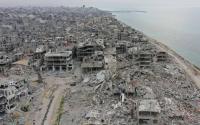Common Dreams / Published on Wednesday, July 9, 2003 by the Los Angeles Timesby Jeffrey D. Sachs and Sakiko Fukuda-Parr
The great paradox of our time is that the massive suffering of the world's poor — from disease, hunger, unsafe water and more — could be readily overcome with just a modicum of help from the richest countries. For less than 1% of the income of the wealthiest countries each year, the worst afflictions of poverty could be substantially reduced, if not eliminated.
Indeed, rich and poor countries have solemnly promised, not just once but at least four times in the last three years, to work to accomplish exactly that: a breakthrough in the elimination of poverty. The greatest puzzle in economic development is not how to alleviate the suffering but how to get rich and poor countries to follow through on their repeated promises.
In 2000, 150 world leaders assembled at the United Nations in New York to help set global goals for the new millennium. At three summits — including last month's Group of 8 meeting in France — support for those goals was reiterated.
The goals emphasize poverty reduction, but they also target related issues such as HIV infection, literacy and child mortality. To achieve them, the richest countries — the United States, Japan and Western European nations — agreed to increase their foreign aid, aiming at a long-term target of seven-tenths of 1% of their national incomes. And poor countries pledged to participate as well, by implementing honest and effective public administration and economic reforms.
The deal was a fair one: more aid in return for good governance. The amazing fact is that financial assistance of up to seven-tenths of 1% of wealthy nations' annual economic output — aid totaling roughly $175 billion at today's income levels — would, if used effectively by the recipient countries, make it possible to control the great pandemic diseases of AIDS, tuberculosis and malaria; increase food productivity of impoverished farmers in the tropics; ensure that children are in school rather than at work; and enable poor households to obtain at least minimally acceptable access to safe drinking water, energy and markets.
The United Nations' 2003 Human Development Report, released this week, cites repeated successes of practical development programs — when financial assistance and fair rules are in place — and outlines in detail how specific investments in health, education, agriculture, water, sanitation and other urgent areas can get the job done.
But it also shows how much work remains. Wealthy countries contribute only two-tenths of 1% of their incomes to the countries in greatest need. As for poor countries, though good governance is still a distant goal in many corners of the world, there are candidates for expanded aid right now: the vibrant democracies of Bangladesh, Bolivia, Ghana, Senegal and Tanzania, among others. These nations are struggling mightily with their poverty and need much more help than they receive.
If poverty reduction is such a straightforward equation, what then explains the inability of the world to follow through on its repeated commitments to the cause?
In the case of the United States, where foreign aid remains the lowest as a share of income in the entire donor world (about $10 billion a year in development assistance in a $10-trillion economy, or one-tenth of 1% of GNP), the main answer seems to be public confusion over what the U.S. is doing and what aid could accomplish. Public opinion polls show that Americans strongly believe that the United States is giving much more help to poor countries than is the case.
Moreover, during the Cold War and even today, too much U.S. foreign aid went to tyrants and crooks for tactical foreign policy purposes, while too little aid was used to fight poverty, hunger and disease. Not only have the amounts been much too small, they have been poorly directed.
It is sometimes claimed that rich countries simply lack the means to provide more financial help, that their budgets are already too strained to donate more to the rest of the world. Yet the United States, Japan and the European Union together spend much more in wasteful subsidies to their own farmers — protecting inefficient sugar producers in temperate climates, for example — than they do in foreign aid.
The question is not whether the rich countries can afford to do more or have to choose between, say, defense and reducing world poverty. Since less than 1% of national income is needed, the question is only whether they will make the elimination of the world's extreme poverty a priority.
The goals established at the millennium conference at the U.N. in 2000 are humanity's best hope for ensuring that globalization is inclusive rather than a benefit for the rich. Yet time is short. The targets for reducing poverty, hunger and disease are set for 2015, a mere dozen years from now.
Wealthy countries must show unequivocally that they are ready to give adequate help — through fairer rules on trade and much more generous aid contributions — to the many poor countries that are ready to help themselves.
There is no more time to lose in creating a world of greater justice, prosperity and shared security.
Columbia University economist Jeffrey D. Sachs is special advisor to United Nations Secretary-General Kofi Annan on the Millennium Development Goals, and Sakiko Fukuda-Parr is director of the U.N.'s 2003 Human Development Report.






